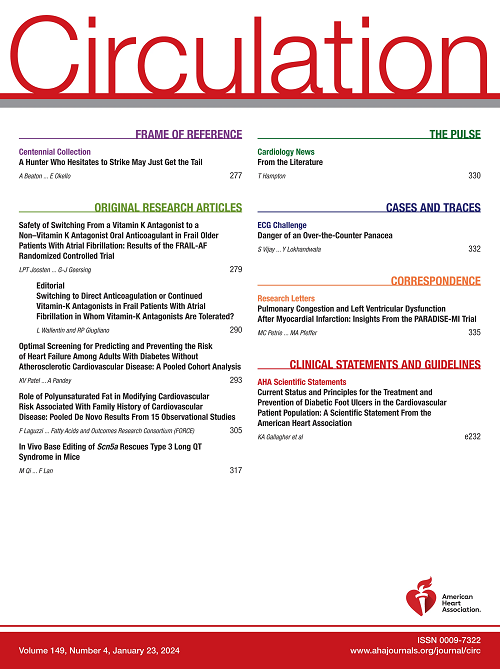持续心电图监测随访的持续性心房颤动脉冲场消融:ADVANTAGE af - 2期。
IF 35.5
1区 医学
Q1 CARDIAC & CARDIOVASCULAR SYSTEMS
引用次数: 0
摘要
背景:脉冲场消融(PFA)治疗持续性心房颤动(PerAF)的安全性和有效性数据很少,而持续性心房颤动的病变通常位于肺静脉隔离(PVI)之外。此外,没有大型试验使用可插入式心脏监测仪(ICMs)在PerAF患者消融后或任何房颤人群PFA后进行持续节律监测。在ADVANTAGE af - 2期中,PerAF患者接受PFA治疗PVI和后壁消融(PWA),在一个亚队列中,接受caavotricuspid峡部消融(CTI)治疗典型心房扑动。方法患者行PVI和PWA,使用pentaspline PFA导管,并在静脉NTG预防后使用新型局线性PFA导管进行CTI。采用ICMs对消融后患者进行为期1年的持续心律监测,以1)模拟传统的间歇监测作为主要疗效终点,2)检查心房心律失常(AA)负担和发作持续时间。结果255例患者(年龄66.7±9.3,女性29%,CHA2DS2-VASc 2.4±1.4,BMI 30.9±5.3,左心房直径4.3±0.6 cm)行PVI + PWA(99.6%/100%急性成功率);一个亚群(n=141;55.3%)也接受了CTI PFA, 98.6%的患者实现了双向阻滞,无并发症(ST段改变、心室颤动)。CTI消融耗时8±13分钟,使用18±6 PF和4±2 mg IV NTG。总手术时间为105±36分钟,心房停留时间为59±24分钟。与传统监测类似,AA缓解率为73.4%,不良事件发生率为2.4%,均符合预先设定的终点标准。心房扑动复发率为97.2%。详细分析完整的ICM数据显示,52.0%的患者无发作≥30秒,94.0%的患者无发作超过24小时。AA负担>.1 %或最长发作持续时间>h均预示着医疗保健利用率的增加。使用≤0.1%负担阈值和<1小时持续时间阈值,1年程序有效性分别为71.6%和70.0%。结论ADVANTAGE af - 2期是首个持续节律监测PFA的多中心PerAF研究:i) CTI消融联合NTG预防是安全有效的,ii) PVI + PWA是安全有效的,iii) AA负担<0.1%和AA发作<1小时持续时间是与最低医疗利用率相关的终点。本文章由计算机程序翻译,如有差异,请以英文原文为准。
Pulsed Field Ablation of Persistent Atrial Fibrillation With Continuous ECG Monitoring Follow-Up: ADVANTAGE AF-Phase 2.
BACKGROUND
There is sparse high-quality safety and effectiveness data for pulsed field ablation (PFA) of persistent atrial fibrillation (PerAF), where lesions beyond pulmonary vein isolation (PVI) are often placed. Additionally, no large trials have used insertable cardiac monitors (ICMs) for continuous rhythm monitoring post-ablation in PerAF patients, or after PFA in any AF population. In ADVANTAGE AF-Phase 2, PerAF patients underwent PFA for PVI and posterior wall ablation (PWA), and in a sub-cohort, cavotricuspid isthmus (CTI) ablation for typical atrial flutter.
METHODS
PerAF pts underwent PVI and PWA with the pentaspline PFA catheter, and CTI with a novel focal-linear PFA catheter after IV NTG prophylaxis. Patients were followed for 1 year with continuous rhythm monitoring after ablation with ICMs to 1) emulate traditional intermittent monitoring for the primary efficacy endpoint, and 2) examine atrial arrhythmia (AA) burden and episode duration.
RESULTS
This 255-patient cohort (age 66.7±9.3, female 29%, CHA2DS2-VASc 2.4±1.4, BMI 30.9±5.3, left atrium diameter 4.3±0.6 cm) underwent PVI plus PWA (99.6%/100% acute success); a subpopulation (n=141; 55.3%) also received CTI PFA, with 98.6% achieving bidirectional block without complications (ST changes, ventricular fibrillation). CTI ablation took 8±13 minutes, using 18±6 PF applications and 4±2 mg IV NTG. The total procedure and atrial dwell times were 105±36 and 59±24 minutes, respectively. Mimicking traditional monitoring, freedom from AA was 73.4% with adverse events in 2.4%, both meeting prespecified endpoint criteria. Freedom from recurrent atrial flutter was 97.2%. Detailed analysis of the full ICM data revealed freedom from AA ≥30 seconds in 52.0%, and no episode exceeded 24 hours in 94.0% of this PerAF cohort. An AA burden >0.1% or longest episode duration >1 hour were both predictive of increased healthcare utilization. One-year procedural effectiveness was 71.6% and 70.0% using these ≤0.1% burden and <1 hour duration thresholds, respectively.
CONCLUSIONS
In ADVANTAGE AF-Phase 2, the first multicenter PerAF study of PFA with continuous rhythm monitoring: i) CTI ablation with NTG prophylaxis was safe and effective, ii) PVI + PWA was safe and effective, and iii) an AA burden <0.1% and AA episode <1 hour duration were endpoints associated with the lowest healthcare utilization.
求助全文
通过发布文献求助,成功后即可免费获取论文全文。
去求助
来源期刊

Circulation
医学-外周血管病
CiteScore
45.70
自引率
2.10%
发文量
1473
审稿时长
2 months
期刊介绍:
Circulation is a platform that publishes a diverse range of content related to cardiovascular health and disease. This includes original research manuscripts, review articles, and other contributions spanning observational studies, clinical trials, epidemiology, health services, outcomes studies, and advancements in basic and translational research. The journal serves as a vital resource for professionals and researchers in the field of cardiovascular health, providing a comprehensive platform for disseminating knowledge and fostering advancements in the understanding and management of cardiovascular issues.
 求助内容:
求助内容: 应助结果提醒方式:
应助结果提醒方式:


